By Leen Randell
Updated: Jul 09, 2024
10 Best Herbal Decoctions For Fluid Retention
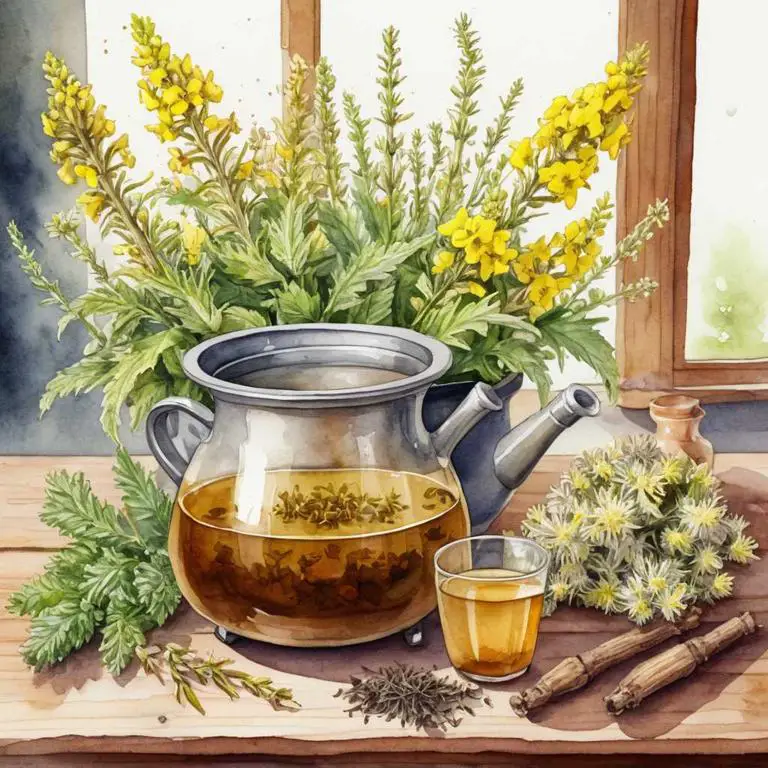
Herbal decoctions for fluid retention are natural remedies made by steeping herbs in hot water to create a concentrated liquid that helps reduce excess fluid buildup in the body.
These decoctions work by stimulating urine production, improving circulation, and relaxing the muscles, all of which help alleviate symptoms such as bloating, swelling, and discomfort. Examples of herbal decoctions that effectively combat fluid retention include dandelion root, peppermint leaf, and corn silk tea.
By incorporating these remedies into their daily routine, individuals can experience improved energy levels, reduced bloating, and a sense of overall well-being, ultimately enhancing the quality of their lives.
The following article describes in detail the most important decoctions for fluid retention, including medicinal properties, parts of herbs to use, and recipes for preparations.
- 1. Urtica dioica
- 2. Taraxacum officinale
- 3. Verbena officinalis
- 4. Glycyrrhiza glabra
- 5. Althaea officinalis
- 6. Echinacea angustifolia
- 7. Solidago virgaurea
- 8. Aesculus hippocastanum
- 9. Verbascum thapsus
- 10. Sambucus nigra
- What is the best combination of herbal decoctions to use for fluid retention?
- What ailments similar to fluid retention are treated with herbal decoctions?
1. Urtica dioica
Stinging nettle decoctions helps with fluid retention because they contain a unique combination of compounds that target the underlying causes of this issue.
The decoction's anti-inflammatory properties help to reduce swelling and alleviate pressure on the lymphatic system, allowing it to function more efficiently in removing excess fluids from the body.
Additionally, nettle's diuretic properties increase urine production, encouraging the kidneys to flush out retained water and electrolytes, leading to a significant reduction in fluid retention.

Medicinal Constituents
The list below shows the primary medicinal constituents in Urtica dioica decoctions that help with fluid retention.
- Stachydrine: Acts as a diuretic, increasing urine production to help eliminate excess fluids from the body.
- Histamine: Although often associated with allergic reactions, histamine in Urtica dioica also has a role in reducing fluid retention by increasing urine production and improving blood flow.
- Alkaloids: Have anti-inflammatory and antioxidant properties, which help reduce swelling and alleviate symptoms of fluid retention.
Parts Used
The list below shows the primary parts of stinging nettle used to make decoctions for fluid retention.
- Leaves: Leaves are a common choice due to their high concentration of bioactive compounds, including flavonoids and phenolic acids, which contribute to their diuretic properties.
- Roots: Roots are used for their ability to promote lymphatic drainage and reduce fluid retention, thanks to their rich content of saponins and other bioactive compounds.
- Stems: Stems are another popular option due to their high levels of vitamin C, flavonoids, and other nutrients that support kidney function and promote the elimination of excess fluids.
Quick Recipe
The following recipe gives a procedure to make a basic stinging nettle for fluid retention.
- Harvest 20-30 grams of dried urtica dioica leaves and stems from a reputable source.
- Crush the dried urtica dioica leaves and stems into a fine powder using a mortar and pestle.
- Combine the powder with 500 milliliters of boiling water in a saucepan.
- Simmer the mixture for 10-15 minutes over low heat to release the active compounds.
- Strain the decoction through a cheesecloth or a fine-mesh sieve into a clean container.
2. Taraxacum officinale
Dandelion decoctions helps with fluid retention because of its unique ability to stimulate the kidneys and promote diuretic functions.
The herb's leaves, roots, and flowers contain compounds that increase urine production, allowing excess fluids to be eliminated from the body more efficiently. This natural diuresis can help alleviate symptoms of water retention, such as bloating and swelling, and provide relief for individuals struggling with conditions like edema or hypertension.
Regular consumption of dandelion decoctions can also help maintain healthy blood pressure levels and promote overall kidney function.

Medicinal Constituents
The list below shows the primary medicinal constituents in Taraxacum officinale decoctions that help with fluid retention.
- Taraxasterol: A triterpenoid saponin that helps reduce fluid retention by inhibiting the reabsorption of sodium and water in the kidneys, thereby promoting diuresis.
- Taraxasterol acetate: A triterpenoid saponin that helps alleviate fluid retention by enhancing the activity of the kidneys and promoting the excretion of excess fluids and electrolytes.
- Quercetin: A flavonoid phenolic compound that helps reduce fluid retention by inhibiting the activity of angiotensin-converting enzyme (ACE), which plays a key role in regulating blood pressure and fluid balance.
Parts Used
The list below shows the primary parts of dandelion used to make decoctions for fluid retention.
- Leaves: Rich in flavonoids and other compounds that help reduce inflammation and improve fluid drainage.
- Roots: Contain inulin, a prebiotic that helps regulate fluid balance and reduce swelling.
- Flowers: High in saponins, which have a diuretic effect and help eliminate excess fluid from the body.
Quick Recipe
The following recipe gives a procedure to make a basic dandelion for fluid retention.
- Harvest the taraxacum officinale roots and leaves in the morning after the dew has dried but before the heat of the day sets in.
- Chop 20-30 grams of taraxacum officinale roots and 20-30 grams of taraxacum officinale leaves into small pieces to enhance extraction.
- Combine the chopped taraxacum officinale roots and leaves with 500 milliliters of cold water in a saucepan and heat over low heat.
- Simmer the taraxacum officinale mixture for 10-15 minutes or until the liquid has reduced slightly and the flavors have melded together.
- Strain the decoction through a cheesecloth or a fine-mesh sieve into a clean glass container to remove solids.
3. Verbena officinalis
Lemon verbena decoctions helps with fluid retention because of its natural diuretic properties, which stimulate the kidneys to eliminate excess water from the body.
The herb's bioactive compounds, such as verbascoside and lemongrass oil, work together to reduce swelling and alleviate the discomfort associated with fluid buildup in tissues and organs.
By promoting urinary frequency and improving circulation, lemon verbena decoctions can help to normalize blood pressure and restore balance to the body's fluid levels, leaving individuals feeling lighter, more energized, and less bloated.
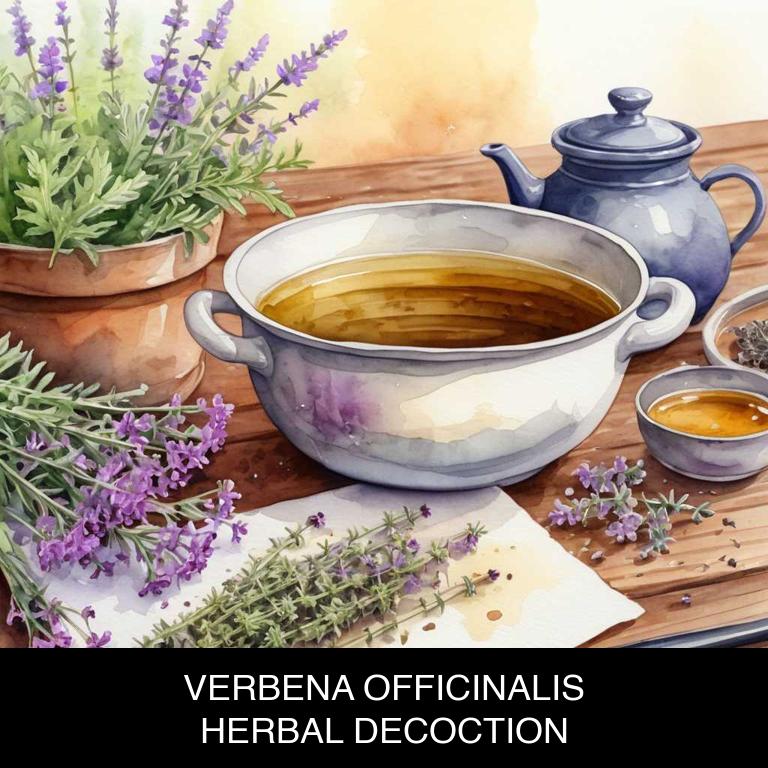
Medicinal Constituents
The list below shows the primary medicinal constituents in Verbena officinalis decoctions that help with fluid retention.
- Iridoid glycosides: These compounds help reduce fluid retention by inhibiting the reabsorption of sodium and water in the kidneys, thereby increasing urine production and reducing swelling.
- Phenolic acids: These compounds have diuretic properties, which help increase urine production and reduce fluid buildup in the body by stimulating the kidneys to remove excess fluids.
- Flavonoids: These compounds have anti-inflammatory and antioxidant properties, which help reduce inflammation and oxidative stress that can contribute to fluid retention, making it easier for the body to eliminate excess fluids.
Parts Used
The list below shows the primary parts of lemon verbena used to make decoctions for fluid retention.
- Leaves: They are used due to their diuretic and anti-inflammatory properties that help reduce fluid retention.
- Roots: They are used for their diuretic and expectorant properties, which aid in reducing fluid retention and promoting urination.
- Stems: They are used due to their ability to stimulate diuresis, helping to reduce fluid retention and alleviate associated symptoms.
Quick Recipe
The following recipe gives a procedure to make a basic lemon verbena for fluid retention.
- Gather fresh or dried verbena officinalis leaves and flowers in equal parts to make a decoction.
- Combine 1 tablespoon of the mixture with 1 cup of boiling water in a heat-resistant container.
- Reduce heat to a simmer and let the mixture steep for 5 to 10 minutes.
- Strain the decoction through a cheesecloth or a fine-mesh sieve into a clean container.
- Store the strained decoction in the refrigerator for up to 24 hours before consumption.
4. Glycyrrhiza glabra
Licorice decoctions helps with fluid retention because of its natural ability to balance the body's electrolyte levels.
The licorice root contains glycyrrhizin, a compound that has a diuretic effect, increasing urine production and reducing water retention in the body. Additionally, licorice root has anti-inflammatory properties that help reduce swelling caused by fluid buildup.
By regulating fluid levels and alleviating inflammation, herbal licorice decoctions can provide effective relief from bloating, edema, and other symptoms associated with fluid retention.

Medicinal Constituents
The list below shows the primary medicinal constituents in Glycyrrhiza glabra decoctions that help with fluid retention.
- Glycyrrhizin: It helps with fluid retention by inhibiting the enzyme 11β-hydroxysteroid dehydrogenase (11β-HSD), which is involved in the conversion of cortisol to its active form, thus reducing the levels of active cortisol in the body and decreasing the amount of water and electrolytes retained.
- Licorice root flavonoids: These flavonoids have a mild diuretic effect, increasing urine production and reducing water retention by improving kidney function and promoting the excretion of excess fluids.
- Glycyrrhetinic acid: It has a mild mineralocorticoid activity, which helps to regulate electrolyte balance and reduce fluid retention by promoting the excretion of sodium and water in the urine.
Parts Used
The list below shows the primary parts of licorice used to make decoctions for fluid retention.
- Roots: The root of Glycyrrhiza glabra is widely used to make decoctions for fluid retention due to its high content of glycyrrhizin, a compound that helps to reduce water retention.
- Leaves: The leaves of Glycyrrhiza glabra are sometimes used to make decoctions for fluid retention, although they are less commonly used than the roots, as they contain smaller amounts of glycyrrhizin.
- Barks: The bark of Glycyrrhiza glabra may be used to make decoctions for fluid retention, particularly in traditional medicine, where it is believed to have diuretic properties and help to reduce swelling.
Quick Recipe
The following recipe gives a procedure to make a basic licorice for fluid retention.
- Harvest 30-60 grams of clean dried roots of glycyrrhiza glabra in late summer or early fall.
- Boil 1 liter of water in a large pot and reduce the heat to a simmer.
- Add the harvested roots to the simmering water and let it steep for 10-15 minutes.
- Strain the liquid from the roots through a cheesecloth or a fine-mesh sieve into a clean container.
- Allow the decoction to cool and then store it in an airtight container in the refrigerator for up to 3 days.
5. Althaea officinalis
Marshmallow decoctions helps with fluid retention because they contain mucilage, a thick, gel-like substance that coats the digestive tract and soothes inflammation.
This natural coating reduces irritation in the body's tissues, allowing excess water to be absorbed and eliminated more effectively. As a result, marshmallow decoctions help reduce fluid buildup in the body, alleviating symptoms of edema, bloating, and other forms of swelling.
By promoting healthy digestion and hydration, marshmallow decoctions provide natural relief from fluid retention.

Medicinal Constituents
The list below shows the primary medicinal constituents in Althaea officinalis decoctions that help with fluid retention.
- Mucilages: Mucilages help with fluid retention by forming a protective barrier on the mucous membranes, reducing inflammation and preventing excess fluid from entering the tissues.
- Phenolic acids: Phenolic acids, such as Gallic acid, help with fluid retention by inhibiting the activity of sodium-potassium pumps, which can contribute to fluid accumulation in the body.
- Flavonoids: Flavonoids, such as Quercetin, help with fluid retention by reducing inflammation and preventing the breakdown of connective tissue, which can lead to fluid accumulation.
Parts Used
The list below shows the primary parts of marshmallow used to make decoctions for fluid retention.
- Roots: The roots of Althaea officinalis are often used due to their high mucilage content, which helps to reduce inflammation and alleviate fluid retention.
- Leaves: The leaves of Althaea officinalis are also commonly used, as they contain similar mucilage properties that aid in soothing and reducing fluid buildup.
- Stems: Although less commonly mentioned, the stems of Althaea officinalis may be used in some herbal preparations, potentially due to their secondary metabolites that contribute to the plant's medicinal properties.
Quick Recipe
The following recipe gives a procedure to make a basic marshmallow for fluid retention.
- Harvest 2-4 ounces of fresh root or 1-2 teaspoons of dried root of althaea officinalis.
- Clean the root thoroughly with water to remove any dirt or debris.
- Crush the root into small pieces to increase its surface area for decoction.
- Combine the crushed root with 2 cups of water in a saucepan and heat gently over low heat for 10-15 minutes.
- Strain the decoction through a cheesecloth or a fine-mesh sieve into a clean container.
6. Echinacea angustifolia
Kansas coneflower decoctions helps with fluid retention because of its ability to stimulate blood flow and improve lymphatic circulation.
The decoction's anti-inflammatory properties also help to reduce swelling and alleviate discomfort associated with fluid buildup. Additionally, the diuretic properties of Kansas coneflower can increase urine production, allowing the body to eliminate excess water and sodium more efficiently.
By addressing these underlying causes of fluid retention, herbal Kansas coneflower decoctions provide natural relief from bloating, swelling, and other symptoms.

Medicinal Constituents
The list below shows the primary medicinal constituents in Echinacea angustifolia decoctions that help with fluid retention.
- Alkylamides: These compounds may help with fluid retention by reducing inflammation and improving the body's natural drainage and circulation processes.
- Iridoid glycosides: Iridoid glycosides, such as echinacystic acid, may help reduce fluid retention by inhibiting the reabsorption of sodium in the kidneys, which can lead to increased urine production and reduced swelling.
- Alkaloids: Although the specific alkaloids present in Echinacea angustifolia are not well-studied, some alkaloids found in other Echinacea species, such as echinatin, may help reduce fluid retention by relaxing the muscles in the kidneys and improving urine flow.
Parts Used
The list below shows the primary parts of kansas coneflower used to make decoctions for fluid retention.
- Roots: The roots are the primary part used due to their high concentration of inulin, which helps reduce fluid retention by promoting diuresis.
- Rhyzomes: The rhyzomes are also commonly used for their similar inulin content to roots, aiding in fluid reduction and diuretic effects.
- Leaves: The leaves are used for their secondary diuretic properties, although less potent than roots and rhyzomes, they still contribute to reducing fluid retention.
Quick Recipe
The following recipe gives a procedure to make a basic kansas coneflower for fluid retention.
- Gather 30-60 grams of dried echinacea angustifolia root and separate it from other plant material.
- Combine the echinacea root with 1 liter of water in a large pot and bring to a boil.
- Reduce heat to a simmer and let the decoction steep for 10-15 minutes with the lid off.
- Strain the decoction through a cheesecloth or fine-mesh sieve into a clean container to remove solids.
- Allow the decoction to cool to room temperature before storing it in the refrigerator for up to 24 hours.
7. Solidago virgaurea
Goldenrod decoctions helps with fluid retention because of its natural diuretic properties, which stimulate the kidneys to release excess water and salt from the body.
The decoction's bioactive compounds, such as flavonoids and phenolic acids, also have anti-inflammatory effects that help reduce swelling and alleviate discomfort associated with fluid buildup.
Additionally, goldenrod's mild astringent properties help to tone and tighten the connective tissue, further reducing the appearance of puffiness and water retention.
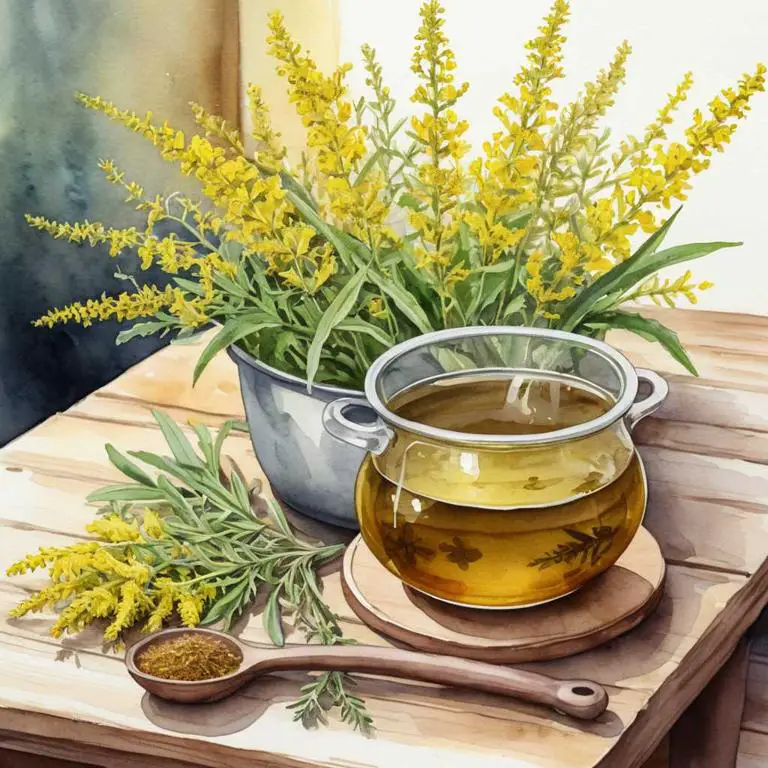
Medicinal Constituents
The list below shows the primary medicinal constituents in Solidago virgaurea decoctions that help with fluid retention.
- Flavonoids: Flavonoids, such as quercetin and kaempferol, in Solidago virgaurea decoctions help with fluid retention by reducing inflammation and improving vascular health, thereby decreasing fluid accumulation in the body.
- Triterpenes: Triterpenes, such as oleanolic acid and ursolic acid, in Solidago virgaurea decoctions help with fluid retention by inhibiting the activity of aldosterone, a hormone that promotes sodium retention and fluid accumulation in the body.
- Phenolic acids: Phenolic acids, such as caffeic acid and ferulic acid, in Solidago virgaurea decoctions help with fluid retention by increasing urine production and reducing sodium reabsorption in the kidneys, thereby promoting the excretion of excess fluids from the body.
Parts Used
The list below shows the primary parts of goldenrod used to make decoctions for fluid retention.
- Roots: The roots of Solidago virgaurea are used to make decoctions for fluid retention due to their diuretic properties.
- Leaves: The leaves of Solidago virgaurea are used to make decoctions for fluid retention due to their ability to stimulate urine production.
- Stems: The stems of Solidago virgaurea are used to make decoctions for fluid retention due to their potential to help reduce water retention in the body.
Quick Recipe
The following recipe gives a procedure to make a basic goldenrod for fluid retention.
- Harvest the solidago virgaurea roots and rhizomes in the fall after the plant has finished flowering.
- Clean and dry the harvested roots and rhizomes to prevent contamination and spoilage.
- Chop the dried roots and rhizomes into small pieces to increase their surface area.
- Combine 1 part of the chopped roots and rhizomes with 4 parts of water in a saucepan.
- Simmer the mixture for 10-15 minutes or until the liquid has reduced to half its original volume.
8. Aesculus hippocastanum
Horse chestnut decoctions helps with fluid retention because it is rich in aesculin, a compound that has a diuretic effect on the body.
Aesculin helps to reduce inflammation and improve circulation, which in turn reduces swelling and bloating caused by excess water retention. As the body eliminates excess fluids, it also reduces pressure on blood vessels, alleviating symptoms of conditions such as varicose veins and hemorrhoids.
By promoting healthy fluid balance, horse chestnut decoctions can provide relief from uncomfortable swelling and discomfort.
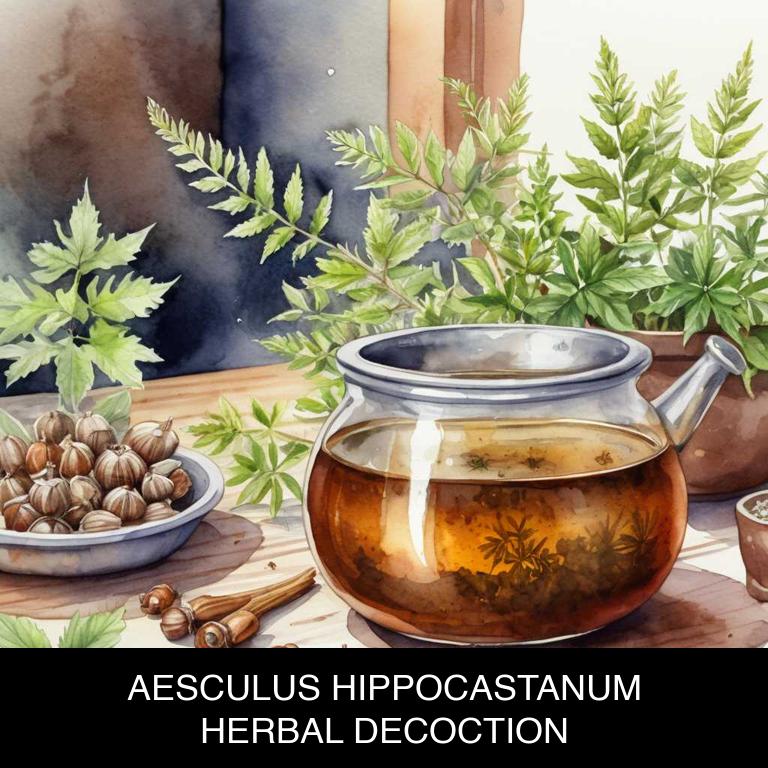
Medicinal Constituents
The list below shows the primary medicinal constituents in Aesculus hippocastanum decoctions that help with fluid retention.
- Saponins: Saponins help with fluid retention by increasing the permeability of blood vessels, allowing excess fluid to be eliminated from the body.
- Phenolic compounds: Phenolic compounds help with fluid retention by reducing inflammation and improving blood flow, which helps the body eliminate excess fluid.
- Steroidal saponins: Steroidal saponins, particularly aescin, help with fluid retention by reducing capillary permeability and improving the integrity of blood vessels, preventing fluid from leaking into tissues.
Parts Used
The list below shows the primary parts of horse chestnut used to make decoctions for fluid retention.
- Roots: Aesculus hippocastanum roots are often used in decoctions to alleviate fluid retention due to their high content of escin, a saponin that helps to reduce swelling.
- Seeds: Horse Chestnut seeds are commonly used to make decoctions for fluid retention because they contain a combination of flavonoids and saponins that help to improve blood flow and reduce swelling.
- Barks: The bark of Aesculus hippocastanum is sometimes used in decoctions to treat fluid retention due to its ability to reduce inflammation and improve circulation.
Quick Recipe
The following recipe gives a procedure to make a basic horse chestnut for fluid retention.
- Harvest 10-20 aesculus hippocastanum leaves and bark from mature trees with no signs of disease or pests.
- Dry the harvested plant material in a warm place or using a dehydrator at 40°c for 2 hours.
- Grind 5 grams of the dried plant material into a fine powder using a mortar and pestle.
- Steep 1 gram of the powder in 200ml of boiling water for 5-7 minutes.
- Strain the decoction through a cheesecloth or a fine-mesh sieve to remove the solids and discard the residue.
9. Verbascum thapsus
Mullein decoctions helps with fluid retention because its diuretic properties stimulate the kidneys to eliminate excess water from the body.
The herb's flavonoids, saponins, and mucilages work together to relax the tissues and reduce inflammation in the body, allowing for easier absorption of fluids and reducing swelling in the extremities.
Additionally, mullein's natural anti-inflammatory compounds help to ease discomfort associated with fluid retention, providing relief from bloating, cramps, and stiffness.
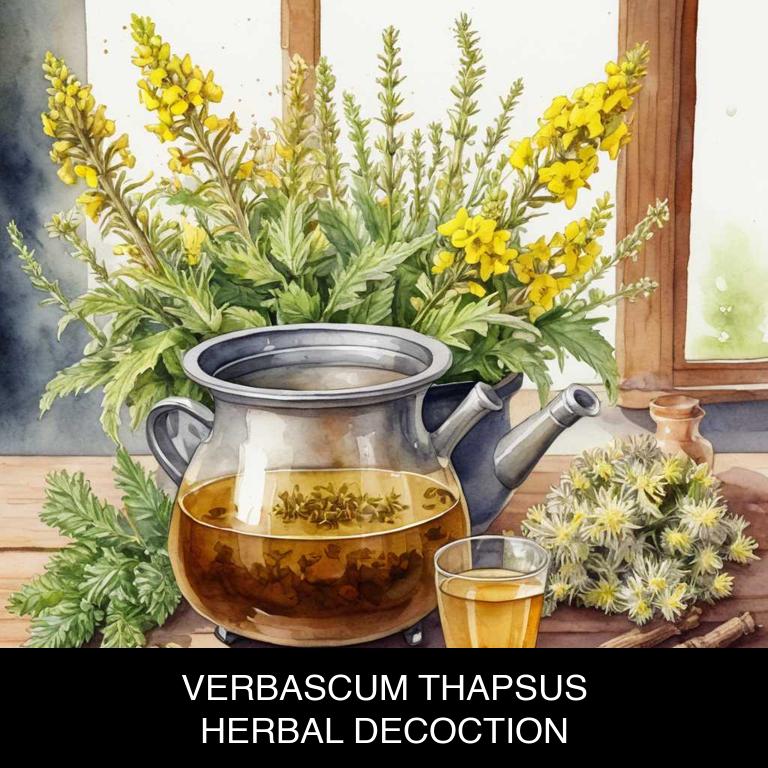
Medicinal Constituents
The list below shows the primary medicinal constituents in Verbascum thapsus decoctions that help with fluid retention.
- Saponins: These compounds help reduce fluid retention by increasing the permeability of the cell membrane, allowing excess fluids to be eliminated from the body.
- Flavonoids: Flavonoids in Verbascum thapsus decoctions help mitigate fluid retention by modulating the activity of the sodium-potassium pump, thereby reducing sodium retention in the body.
- Triterpenes: Triterpenes have diuretic properties, helping to reduce fluid retention by increasing urine production and promoting the elimination of excess fluids from the body.
Parts Used
The list below shows the primary parts of mullein used to make decoctions for fluid retention.
- Leaves: They are used to make decoctions for fluid retention as they contain compounds that help reduce swelling and edema.
- Roots: The roots are used for their diuretic properties, helping to increase urine production and reduce fluid retention.
- Stems: The stems of Verbascum thapsus are also used to make decoctions for fluid retention, possibly due to their ability to promote sweating and diuresis.
Quick Recipe
The following recipe gives a procedure to make a basic mullein for fluid retention.
- Harvest fresh verbascum thapsus flowers and leaves in the morning after dew has evaporated.
- Dry the harvested plant material in a warm dry place for 7 to 10 days.
- Combine 1 part dried verbascum thapsus with 2 parts water in a saucepan and bring to boil.
- Reduce heat and simmer for 10 to 15 minutes or until the liquid is reduced by half.
- Strain the decoction through a cheesecloth or fine mesh into a clean container and discard solids.
10. Sambucus nigra
Elder decoctions helps with fluid retention because they are rich in bioactive compounds that have a diuretic effect, stimulating the kidneys to release excess water from the body.
The anti-inflammatory properties of elderberry also help reduce swelling and edema, making it an effective remedy for conditions such as water retention, bloating, and puffiness.
Additionally, elder decoctions can help regulate blood pressure and improve circulation, which further contributes to reducing fluid buildup in the body.
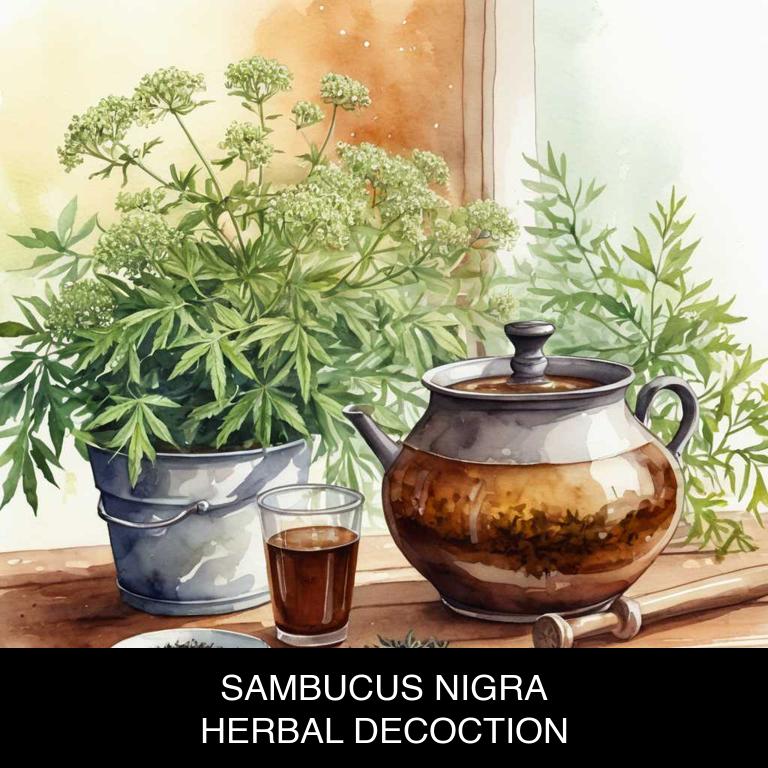
Medicinal Constituents
The list below shows the primary medicinal constituents in Sambucus nigra decoctions that help with fluid retention.
- Flavonoids: They help reduce fluid retention by exerting diuretic and anti-inflammatory effects, thereby improving kidney function and reducing swelling.
- Phenolic acids: They have a diuretic effect, which helps in eliminating excess fluids from the body and reducing edema.
- Isoflavones: They help reduce fluid retention by exerting antioxidant and anti-inflammatory effects, which can improve kidney function and reduce swelling.
Parts Used
The list below shows the primary parts of elder used to make decoctions for fluid retention.
- Flowers: The flowers are used due to their high concentration of flavonoids and other compounds that help to reduce inflammation and improve lymphatic drainage.
- Leaves: The leaves are used for their diuretic properties, which help to increase urine production and reduce fluid retention.
- Fruits: The fruits are used for their anthocyanins and other compounds that have anti-inflammatory and diuretic effects, helping to alleviate fluid retention and improve overall health.
Quick Recipe
The following recipe gives a procedure to make a basic elder for fluid retention.
- Harvest 1 cup of fresh or 2 cups of dried sambucus nigra flowers and leaves.
- Clean and chop the collected sambucus nigra material into smaller pieces.
- Combine the chopped sambucus nigra with 4 cups of water in a saucepan.
- Bring the sambucus nigra mixture to a boil then reduce the heat to a simmer.
- Allow the sambucus nigra decoction to steep for 10 to 20 minutes then strain.
What is the best combination of herbal decoctions to use for fluid retention?
The best combination of herbal decoctions that help with fluid retention is a blend of Dandelion root, Milk Thistle, and Ginger.
Dandelion root aids in reducing fluid retention by promoting diuresis and liver function. Milk Thistle supports liver health, which in turn, helps in processing and eliminating excess fluids. Ginger adds warmth and aids in circulation, further assisting the body in releasing retained fluids.
This trio can be combined to create a soothing and effective herbal decoction for fluid retention.
What ailments similar to fluid retention are treated with herbal decoctions?
Ailments similar to fluid retention that are treated with herbal decoctions are kidney stones, urinary tract infections, and edema.
Herbs such as uva ursi, juniper berries, and goldenseal have been traditionally used to treat these conditions due to their diuretic and anti-inflammatory properties.
They help to increase urine production, reduce swelling, and alleviate discomfort associated with these conditions.